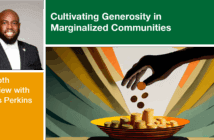Due to COVID-19 restrictions most churches have adopted new ways of taking up the collection. Ann Michel of the Lewis Center staff says it’s important that these new methods honor the central role of offering in worship and invite everyone to give.
The familiar ritual of passing the plate has fallen victim to the pandemic. Many churches worshiping online have put in place online giving mechanisms. And for churches resuming in-person worship, CDC guidelines discourage the use of frequently touched objects. They specifically recommend the use of a stationary collection box or electronic giving. These changes raise the question, how can we still honor the central role of offering in worship as our methods for receiving offerings evolve?
There is nothing sacrosanct about passing the plate, of course. In some religious traditions it has never been the norm. And a trend toward different ways of taking up the collection has been underway for some time. But before relegating the quaint ritual of passing the plate to the dustbin of church history, we should at least stop to consider what it accomplishes and make sure alternate methods of receiving gifts achieve the same objectives.
Keep offering central to worship
An offering is more than a way for the church to underwrite its expenses or the implicit price of admission, even though we often think and speak of it that way. Our spiritual ancestors worshipped God by offering gifts of grain and livestock. These gifts were a meaningful, tangible demonstration of their devotion to God because they represented a sacrifice of what was most valuable to them. In a similar manner, our monetary gifts are a sacrifice of what is essential to our livelihood. They are a tangible expression of our love of God. Making an offering is the most ancient and elemental way we worship God. From a theological perspective, offering should be part of every expression of Christian worship. When framed properly, the ritual of passing the plate can be a powerful symbol of the centrality of offering to worship.
As churches adopt alternate ways of taking up the collection, it’s still important to make offering a central feature of worship. Is there a designated time to invite people to give? To explain the theological significance of giving? To share some of the good that giving accomplishes? And to dedicate or bless people’s gifts (including those given electronically)? These practices reinforce the connection between giving and worship, regardless of the means by which the collection is received.
Present everyone with the opportunity to give
When the plate is passed, every worshipper has the opportunity to give laid before them, quite literally. While some may find this distasteful, there is definitely something to be said for receiving an offering in a way that connects directly with every participant and can’t be overlooked. I’ve been in many church services where collection plates or boxes are posted inconspicuously at the doorways. But the majority of people walk right by, not noticing them and sometimes not even understanding what they are for. And, as churches have moved to online worship, many have struggled with how to present giving in the context of an online service.
Participating in the offering should be an active element of the service, not an afterthought or something that can be easily overlooked or forgotten. Some churches, for example, are placing their collection boxes at the altar and inviting people to come forward during the offering, or as they come forward for prayer or to receive the sacrament. “Text to give” is another way for worshipper, both online and in person, to give during the context of worship.
Sustain the witness of generosity
When we give in the context of public worship, we are modeling generosity for others. It is a form of witness. When my children were young, I knew they were watching when I placed my gift in the offering plate each Sunday. And I believe other worshippers, too, are influenced by how they see me and other church leaders participate in the offering. So, with our offering plates sidelined, it is more important than ever to share the witness of generosity in other ways, perhaps through testimonies or telling stories of generosity and what it accomplishes in service of God’s mission.
Let me be clear. Even in the best of times, churches should never rely exclusively on the offering plate or any other way of receiving gifts that is limited to those who happen to be in attendance any given Sunday. Vital churches provide their members with a variety of ways to give. One positive consequence of the coronavirus response is that many churches that had not previously provided online giving have catapulted themselves into the 21st century. As we embrace new and varied ways of giving, let’s not forget what our dusty old collection baskets can teach us about keeping offering central to worship and inviting everyone to give.
Related Resources
- Theology of Stewardship and Biblical Generosity Video Tool Kit
- Now Is the Time to Ask Contributors to Set Up Recurring Online Gifts by Lovett H. Weems Jr. and Ann A. Michel
- 9 Ways Leaders Can Promote Faithful Stewardship by Ann A. Michel






